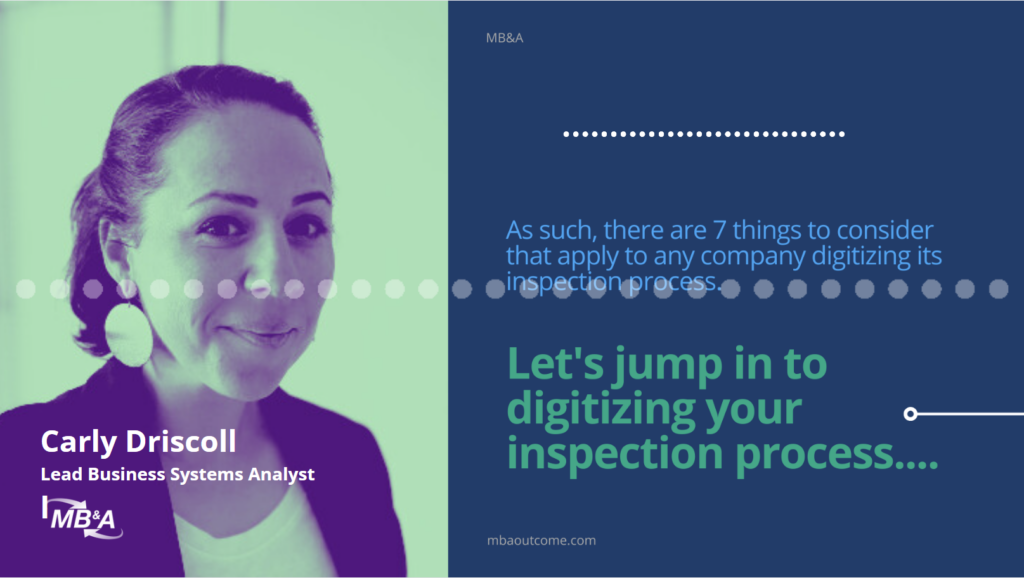In the age of technology, most companies, if they haven’t done so already, are either considering or actively working on digitizing its inspection processes. This is no small thing – it can cost you time, patience, and money. Finding the right technology to fit your needs is complex and challenging. Purchasing an out-of-the-box technology is hit or miss, but most often leaves the end-user with a wishlist of unmet requirements. Part of this is because your company is not generic, and broadly applied technologies are by design.
As a Business Systems Analyst, I spend a lot of time reviewing and assessing a process to determine the steps necessary to digitize them. Depending on the industry, company size, and type of process moving to a digital environment, this could mean a lot of different things. Each company is unique and has its own set of requirements.
While all processes are subjective to a company, the challenge to move a process into a digital environment is as unique as the company it supports. As such, there are 7 things to consider that apply to any company digitizing its inspection process.
So, before you jump into digitizing your inspection process:
1. State the objective.
Why do you want to digitize the process? Is it to save time, track the lifecycle, training and development? The list goes on. Only you can say what is important to your company and why. For example, during an inspection maybe you have a step that requires input from an outside source, and through digitization, you want to be able to generate reports, questions, and feedback without manually creating all of those things. In this scenario, the object would be to digitize the process in order to automate standard steps and actions. This is important because it’s the foundation to the final step (see step 7).
2. Map the “as-is” process
Everyone knows that the current state process should be mapped; however, sometimes the current state is not always clearly understood. Often a process is mapped as it ‘should be done, rather than how it’s ‘really’ done. Document the ‘real’ process; what questions need to be answered along the way, how many ways can a question be answered, and what is the next step for each of those options. For many industries, the processes have been manual for so long, legacy knowledge is a big part of knowing what comes next. If we look at a pre-production inspection process for example, one of the steps would be to verify the availability of materials. In the documented process, the inspector would review material shipping status and/or inventory levels and likely record a pass/fail. But what if the inspector doesn’t have access to the status? Or maybe they see the inventory system shows an on-hand quantity, but the location is empty. What is the expected next step? This is important because in a digital environment, you want to know the technology you’re going to employ has the ability to set standards and deviations.
3. Define the process expectations
For each inspection step, there is an expectation. Think inputs and outputs, if ‘A’ happens, what comes next? Or if ‘A’ doesn’t happen, then what? In some inspections, it’s a single input for every output, but other times it can be grouped. For example, when building a machine, I may be verifying something acts a certain way, and if it doesn’t, the inspection fails and I need to provide a reason. In another scenario, I may expect it to act a certain way, but instead of failing the inspection, I just need to leave feedback and flag a note. Defining what comes next ‘if’ is a critical part of determining the right technology to support your process.
4. Clarify the “who” in every step of the process
Who are the people involved in the process and what role do they play? Who is responsible for what? Who can access the information? Who can answer the questions? Who can ask the questions? Similarly to step two, knowing who does what is a part of the process. In most inspections, you have an inspector, a responsible party that oversees or owns the thing being inspected, and potentially a number of people who will need to be notified depending on the inspection results. For example, in a home purchase inspection, you have an inspector, a buyer, a lender, a realtor, and a homeowner. Most of this list consists of people being made aware of something, but that isn’t always the case. Knowing who the input sources are, who should be involved, and when will help determine the complexity of the system and the technology needed.
5. Qualify the type of information collected
Information comes in a variety of forms, and depending on what type you are reviewing, collecting, or disseminating, your digital system may or may not be able to support it. For example, are you collecting factual information based on a visual or interactive testing process? Are you collecting analytical information? Maybe you need to review and collect subjective details that are defined by legacy knowledge. Qualifying information sets you up to use those details to answer a question.
6. Determine how the information is used
Because information comes in different forms, understanding the intent and purpose is important. For example, maybe you need to verify end-user requirements, but instead of a pass/fail, you want to produce a numeric value. Or maybe you are collecting numeric scores over a period of time to be used to determine an activity requirement. Whatever the case, make sure you know how you want the details to work.
7. Outline the information that tells a story
The final step is to determine what key pieces of information are most important to your organization. Referring back to step 1, what story do you need to tell? If process lifecycle and duration are the metrics that drive success, then ensuring the technology captures each step with a date/time stamp is imperative. For every need, there is someone trying to sell you a solution. The trick is to ensure the solution doesn’t cost you more money, time, and patience than not having it in the first place.
Conclusion:
Inspections are a necessary part of quality and review. In any industry, any company, and any environment inspections are used to validate and verify all sorts of things. Maybe you work in manufacturing where there are many inspection and quality processes used to ensure the product and production process are completed as expected. In housing and urban development, inspections are used to verify building codes, or to ensure a facility meets the lending requirements. The list goes on and on. One thing is for certain if you follow these 7 steps your digitization process will go much smoother and will start showing efficiencies faster.





